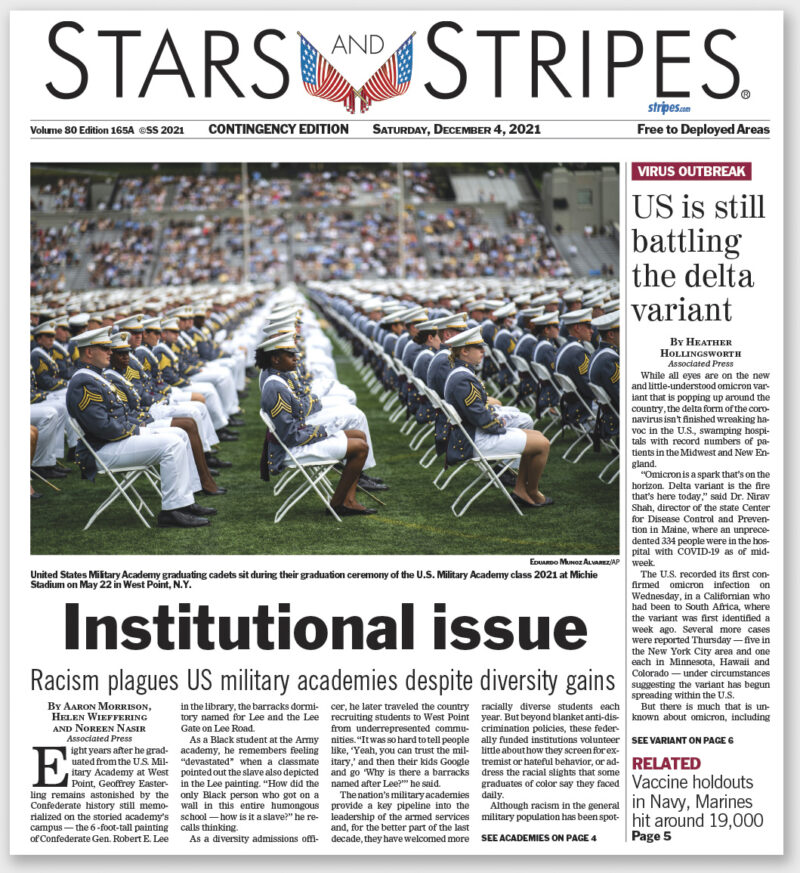Interviews with graduates and an exclusive data analysis exposed racial disparities and examples of lingering racist attitudes at the armed forces’ prestigious academies.
A groundbreaking story on racism and discrimination at the five elite U.S. military academies, exposing racial gaps in the makeup of the academies’ student bodies and graduation rates, has earned Aaron Morrison, Helen Wieffering, Noreen Nassir and Jasen Lo honors for Best of the Week.
The military likes to say that all service members wearing the same uniform are equal, but the AP’s investigation showed that simply is not true, based on experiences related by many graduates of color, and exclusive analysis of decades of data obtained from four of the five service branches.
In an AP story earlier this year, current and former enlistees and officers in nearly every branch of the armed services described a deep-rooted culture of racism and discrimination, despite repeated efforts to eradicate it. Less attention has been paid to the premiere institutions that produce a significant portion of the services’ officer corps — the academies of the U.S. Army, Navy, Air Force, Coast Guard and Merchant Marine.
Current and former academy attendees were initially reluctant to speak out, but New York-based race and ethnicity reporter Morrison and his colleague, video journalist Nasir, joined by global investigations reporter Wieffering, painstakingly gained the trust of their subjects, who described painful experiences of being singled out for non-existent infractions or treated like the stereotype of an angry Black man. They also spoke about feeling alone and being fearful of retaliation if they complained about discriminatory treatment.
Chicago-based data intern Lo handled the analysis of demographics and graduation rate data obtained by Morrison in a Freedom of Information Act request. The AP’s analysis of data supplied by the Naval, Air Force, Merchant Marine and Coast Guard academies showed the schools generally have become more diverse over the past two decades, but that not all non-white groups saw appreciable changes.
At the Naval Academy, for instance, there were 73 Black midshipmen in the class of 2000 — and just 77 in 2020. At the Coast Guard Academy, there were 15 Black cadets in the 2001 class and merely 16 in 2021.
The data analysis also found disparities in the graduation rates between racial groups at the Naval and Coast Guard academies.
Nasir produced the video accompanying the story while New York photo editors Julie Jacobson and Pamela Hassell were the chief drivers behind obtaining evocative then-and-now photos of some of the chief subjects, as well as file historical that helped tell the tale.
The deeply reported package was capped by a compelling digital presentation by Phoenix-based Samantha Shotzbarger, of the digital storytelling team.

Bob Reid, longtime AP foreign correspondent and now senior managing editor of Stars and Stripes, the independent military news outlet, praised the story — which won prominent display on Stars and Stripes’ website and on the front page of the global print edition — for presenting “a picture of subtle, lingering racism despite official policies promoting racial equality. ... The AP’s report resonated with Stars and Stripes editors because it reflected observations of our own staff reporting on the military community,” Reid wrote in an email, citing such details as the fact that only 6% of Congressional nominations to the Army, Air Force and Navy academies went to Black candidates.
For an enlightening and enterprising story that showed how far the U.S. military still needs to go to rectify racial inequality at its prestigious service academies, the team of Morrison, Wieffering, Nasir and Lo earns Best of the Week — First Winner.
Visit AP.org to request a trial subscription to AP's video, photo and text services.
For breaking news, visit apnews.com








